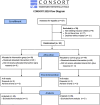Effects of pain education on disability, pain, quality of life, and self-efficacy in chronic low back pain: A randomized controlled trial
- PMID: 38805446
- PMCID: PMC11132453
- DOI: 10.1371/journal.pone.0294302
Effects of pain education on disability, pain, quality of life, and self-efficacy in chronic low back pain: A randomized controlled trial
Abstract
Background: Low back pain stands as a prevalent contributor to pain-related disability on a global scale. In addressing chronic low back pain (CLBP), there is a growing emphasis on incorporating psychological strategies into the management process. Among these, pain education interventions strive to reshape pain beliefs and mitigate the perceived threat of pain. This randomized controlled trial sought to assess the effects of pain education on various aspects, including pain levels, disability, quality of life, self-efficacy, and prognostic characteristics in individuals grappling with CLBP.
Methods: The clinical trial, retrospectively registered with the Clinical Trials Registry of India (CTRI/2021/08/035963), employed a two-arm parallel randomized design. Ninety-two participants with CLBP were randomly assigned to either the standard physiotherapy care with a pain education program or the control group. Both groups underwent a 6-week intervention. Assessment of pain intensity (using NPRS), disability (using RMDQ), self-efficacy (using the general self-efficacy scale), and well-being (using WHO 5I) occurred both before and after the 6-week study intervention.
Findings: Post-intervention score comparisons between the groups revealed that the pain education intervention led to a significant reduction in disability compared to the usual standard care at 6 weeks (mean difference 8.2, p < 0.001, effect size Cohen d = 0.75), a decrease in pain intensity (mean difference 3.5, p < 0.001, effect size Cohen d = 0.82), and an improvement in the well-being index (mean difference 13.7, p < 0.001, effect size Cohen d = 0.58).
Conclusion: The findings suggest that integrating a pain education program enhances the therapeutic benefits of standard physiotherapy care for individuals dealing with chronic LBP. In conclusion, the clinical benefits of pain education become apparent when delivered in conjunction with standard care physiotherapy during the management of chronic low back pain.
Copyright: © 2024 Sidiq et al. This is an open access article distributed under the terms of the Creative Commons Attribution License, which permits unrestricted use, distribution, and reproduction in any medium, provided the original author and source are credited.
Conflict of interest statement
The authors declare that they have no known competing financial interests or personal relationships that could have appeared to influence the work reported in this paper.
Figures
References
-
- Ferreira ML, de Luca K, Haile LM, Steinmetz JD, Culbreth GT, Cross M, et al.. Global, regional, and national burden of low back pain, 1990–2020, its attributable risk factors, and projections to 2050: a systematic analysis of the Global Burden of Disease Study 2021. The Lancet Rheumatology. 2023;5(6):e316–29. doi: 10.1016/S2665-9913(23)00098-X - DOI - PMC - PubMed
Publication types
MeSH terms
LinkOut - more resources
Full Text Sources
Medical
Miscellaneous



